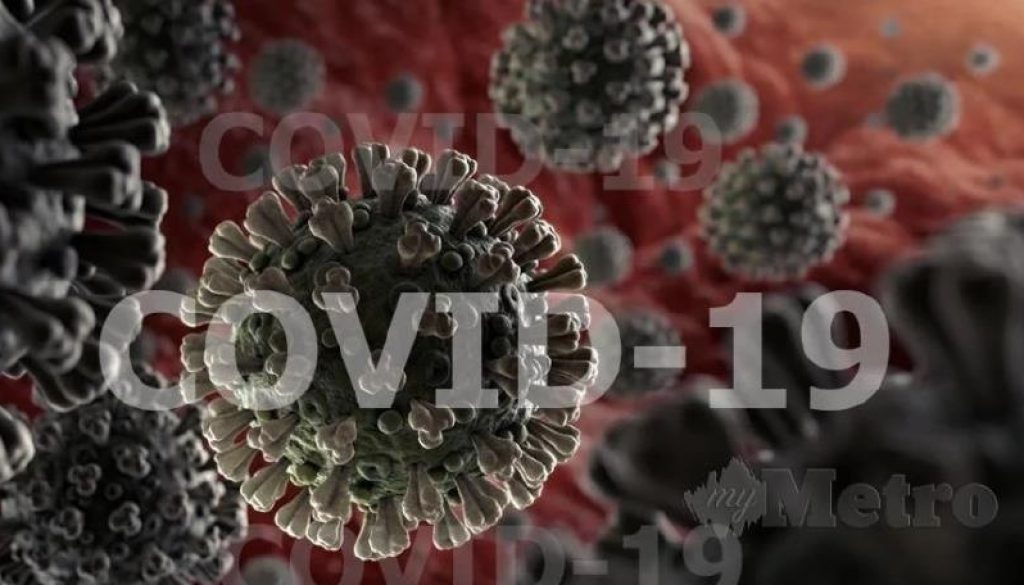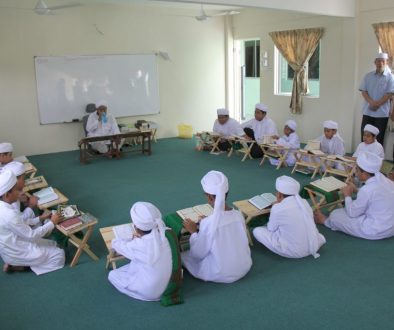COVID-19 AND VENTILATION ENGINEERING
Since the Movement Control Order was introduced from March 18, social media apps WhatsApp and Facebook have not been silent with various comments by netizens about the Covid-19 virus and its effects on humans. What an irony that such a microscopic creature of Allah SWT is able to create a huge pendemonium on human life.
Source: Lew Harriman
Humans are exposed to various types of bacteria and viruses at all times; it is only that certain types of bacteria and viruses that can be harmful to human health. In addition, people spend a lot of time living in the office. Generally one third of our time is spent in the office. Have we ever wondered, is the air in our office really clean? Are we free from infection if the air in the office is exposed to various chemicals and pathogens? Have we ever had a bad smell when entering a hotel room? Have we seen some stain marks on wall like the enclosed photo [1]?
Ventilation is defined as the process of supplying or discharging air from a space with the aim of controlling the level of pollution, humidity and temperature of the space. According to the Occupational Safety and Health Act 1994, it is the responsibility of employers and building owners to provide safe workplaces to employees or occupants of a building, especially to air-conditioned buildings. Through the Industry Code of Practice on Indoor Air Quality 2010 [2], the level of exposure to chemical and biological and the suitability of physical parameters such as temperature and humidity are specified. In addition, the mechanisms for identifying, assessing and controlling indoor air pollution, and occupational safety and health measures are also outlined.
The importance of relative humidity (RH)
Usually we will feel uncomfortable and irritated when the office air-conditioner is not operating properly. We also feel sensitive if the conditioned air supplied is too hot or too cold.
The function of the air conditioning system is not simply to supply conditioned air. The conditioned air also supplies oxygen while filtering out dust, dirt, odors and pathogens from inhalation while we breathe. The air must also have relative humidity that is suitable for humans as well as at levels that control the reproduction of bacteria and fungus. Relative humidity refers to the amount of water vapor content in each kilogram of dry air. For example, relative humidity of 20% refers to dry air such as climate in Mecca, while at RH of 90% the sensation is humid similar to the feeling before rain.
Generally, engineers design air conditioners based on ASHRAE standards (American Society of Heating, Refrigeration and Air-conditioning Engineers) tailored to the Malaysian climate. The psychrometric chart shows the specified range of air conditioning parameters based on Malaysian Standard MS 1525 which is 24.5 +/- 1.5 ° Celsius and relative humidity of 60 +/- 10%.

What does this chart have to do with the transmission of the Covid 19 virus? According to Dr. Stephanie Taylor of the United States; a medical doctor and architectural expert, she stated “Ten years ago, we learned that viruses studied as surrogates for Coronavirus, the family of SARS and Wuhan, were INACTIVATED on surfaces when the ambient relative humidity (RH) was 40-60%. Conversely, when RH was either below 40% or above 60%, the viruses remained virulent and infectious” [3].
Obviously, one way to control the outbreak of infection through the air-conditioning system is by controlling the humidity level! Proper control of the air humidity is important to control the reproduction of micro-organism in air.
Unfortunately from past experience, the writer, while conducting audits in some buildings had found that the air conditioning system did not meet the expected performance. For example, if there is black stain in the air funnel on the ceiling, it is an indication of fungus growth in the ceiling. There are even air conditioned areas with a relative humidity of up to 80% despite having acceptable air temperatures. As a result, one can see some water droplets due to condensation on air-conditioning diffusers.
Supply of oxygen and removal of carbon dioxide
The air conditioning system also works to deliver oxygen into the building. The Department of Occupational Safety and Health (DOSH) Malaysia sets out the requirement of having fresh air in air-conditioned spaces. This requirement is set forth in the Industry Code of Practice on Indoor Air Quaity 2010 which sets the maximum limit on carbon dioxide (CO2) content not exceeding 1,000 ppm (parts per million) and carbon monoxide (CO) not exceeding 10 ppm.
Split-unit type air conditioning systems are often used at home or in the office. Compared to a central air-handling unit (AHU) system that brings fresh air through ducting, split-unit system works by simply recirculating air in a space. If the fresh air is not brought into this air space, the CO2 content will continue to rise from the respiration while the oxygen concentration will slowly decrease. High CO2 concentration in humans will induce people into dizziness, drowsiness and lack of concentration.
Source: AHAR Consultants PLT
Imagine if this recycled air was used in the waiting room of a clinic or hospital as shown in the accompanying photo which was taken by the author at a government health clinic. There could be various viruses and bacteria in the air that could infect visitors and all health workers!
How clean is the air we breathe?
Foul smell is also an indicator of the performance of the air conditioner when it is not working optimally. This odor is due to the chemical reaction that occurs when there is fungus on moist surface. When the air conditioner fails to adequately dehydrate the air stream (moisture exceeds 65% relative humidity), this promotes fungal and micro-organism reproduction. Black spots on the ceiling or walls are indicative of fungal colony breeding. DOSH sets a total Bacterial Count of 500 cfu / m3 (coloni forming units per cubic meter) while the Total Fungal Counts at maximum of 1000 cfu / m3 for office buildings.
Source : AHAR Consultants PLT
Requirements for health buildings are more stringent and referenced in the ASHRAE 170 (Ventilation of Health Care Facilities) Standard. In addition to moisture, fungi need food to survive. This fungal food comes from organic dust that sticks to the surface or microscopic holes. Therefore, air must be filtered to ensure that no dust passes through.
The use of filters for this air conditioning system depends on the use of space. For example, for critical rooms such as surgery or intensive care, a HEPA (High Efficiency Particulate Air) filter is used. For comparison, split-unit filters can only filter up to 10 micrometers (μm) while HEPA filters can filter as small as 0.3 micrometers. It means split-units filter can allow 33 times larger organism to pass through than HEPA filter. If the reader can sight dusts around air diffusers, it indicates that the air filter is not functioning properly.
The role of air movement in air-conditioning system
Recently, a group of researchers from Guangdong China has conducted a research on transmission of Covid-19 through aerosol. They investigated the role of aerosol in the transmission of Covid-19 virus in building and the effect of ventilation air movement within the environment [4]. The study looked at the relationship between disease transmission in a confined restaurant and air-conditioning system operation.
The study links the location of air-conditioner blower; which affects the airflow movement pattern, to the transmission of Covid-19 within the restaurant environment. The study confirms that virus transmission happens not only through droplet transmission, it can also be transmitted through aerosol transmission. Air flow pattern and velocity of air stream also play an important role in propagation of aerosol within a confined space.
The outdoor air ventilation rate is also important in controlling the room aerosol concentration. The average room concentration of aerosol is a function of ventilation rate and source strength. Study by Gao et al. (2016) showed that relative contribution of aerosols to respiratory infection is a function of ventilation rate. When the ventilation rate in a room is low, the room’s concentration of aerosol from exhaled air becomes highly concentrated. In the case above, the average air flow was found to be between 1.04 L/s to 0.75 L/s per patron compared to ASHRAE’s Standard 62.1 of 8-10 L/s per person.
In the case of the restaurant under study, it was found that none of the waiters were infected despite serving the affected tables. The researchers conclude that this could be due to short exposure time to the exhaled aerosol of the index patient. The study also confirms that occupancy density also contributes to the infection rate.
What do we learn from this Covid-19 pandemic?
The world has bet most of its research funding on finding a vaccine and effective drugs. That effort is vital, but it must be accompanied by research on how to target and improve the non-drug interventions that are the only things that work so far. Debates still rage over basic questions such as whether the public should use face masks; whether we should stand 1, 2 or 4 metres apart; and whether we should wash our hands with soap or sanitiser [5].
Other non-drug options to research include the built environment, such as ultra-violet irradiation, ventilation, air conditioning circulation, and surface material (if the virus can “die” faster on certain surfaces).
The air conditioning system not only provides air to the building but also serves as a lifeline for us from supplying oxygen to controlling air pollution that causes infection. Air-conditioning and ventilation are a complex and important science for the sustainability of life. All these while, we have taken for granted the design and maintenance requirements of the air conditioning system. Just look at the air conditioners in your office for any signs of negligence because who knows, someday there will be another virus that can cause such a pandemic.
For professionals in the field of building construction, the performance of the air conditioning and ventilation systems depends on the cooperation between developers, mechanical engineers and contractors. The ventilation system will only work properly when it is well designed and the building envelope is well built. Buildings need to be built air-tight to prevent intrusion of air and dust from the outside for proper moisture control and cleanliness. Indoor air flow must be well understood. We can use computational fluids dynamics (CFD) simulations to make sure the airflow works as desired. Engineering practitioners need to equip themselves with more advanced technical competencies.
From this pandemic, our society, especially the building developers and construction industry professionals, should re-evaluate the importance of ventilation engineering in the context of our health well-being.
References
- Diagnosing and fixing humidity control problems in real-world buildings; Lew Harriman, 2013
- DEPARTMENT OF OCCUPATIONAL SAFETY AND HEALTH, MINISTRY OF HUMAN RESOURCES, MALAYSIA , JKKP DP(S) 127/379/4-39
- https://www.hpac.com/industry-perspectives/article/21125154/editors-notes-iaq-ieq-public-health-humidity-controls
- Evidence for probable aerosol transmission of SARS-CoV-2 in a poorly ventilated restaurant; https://www.medrxiv.org/content/10.1101/2020.04.16.20067728v1
- https://www.weforum.org/agenda/2020/05/vaccine-coronavirus-alternatives-covid19-vaccinations/
Citation
- https://www.sinarharian.com.my/article/79266/KOLUMNIS/Kawalan-udara-elak-Covid-19
- https://www.hmetro.com.my/mutakhir/2020/04/567828/pastikan-penghawa-dingin-bersih-dan-sesuai





